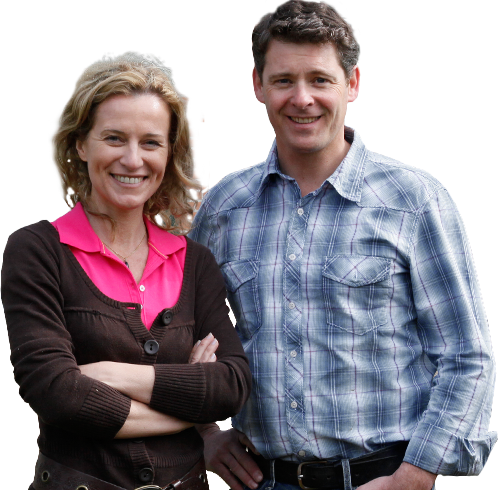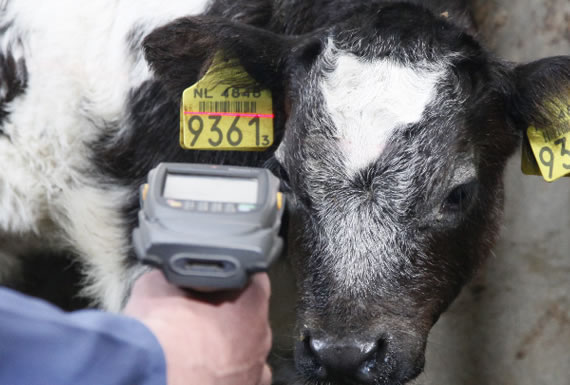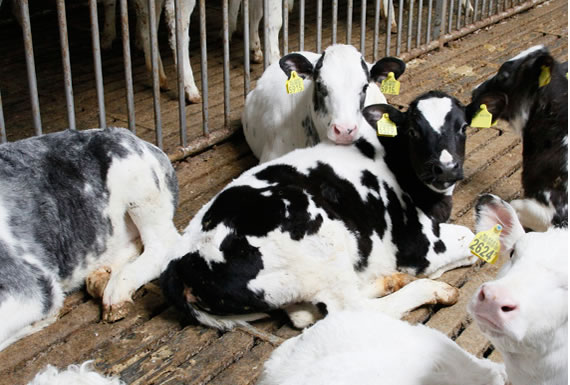Welcome. Feel free to take a look around the calf stall.
Calf husbandry

The stable

Raughage
In line with their natural behaviour, calves are fed roughage such as corn, grains and pellets every day. Calves start to eat roughage when they are around two weeks old, and they eat more of it as they get older. The combination of roughage and calf milk ensures a balanced diet.
Feeding roughage to calves became a legal requirement in 1998. Even without this legislation, however, veal farmers would still continue to feed roughage to their calves, since research has shown that roughage is essential to a good digestive system. This in turn is necessary to keep the calves fit and healthy.
Feeding Calves
Calves receive plenty to eat and drink. The calf milk composition is monitored carefully to guarantee a consistently high quality. This is key to ensuring the animals stay in top condition. As well as calf milk, they are fed fibre-rich products such as corn, grains and pellets.
Calf milk is always prepared fresh in the feed kitchen. From a large vat, it flows into a trough that connects all the feeding trays in the stall. There is more than enough room for all the calves to drink at the same time, so there’s no need to push and shove!
A calf always spends at least the first 14 days of its life on the farm where it was born. It is fed colostrum, also known as ‘beestings’. This is the first milk produced by a cow after giving birth and it provides the calf with important antibodies.
Drinking water

Calves have round-the-clock access to as much fresh drinking water as they want. Each group has its own drinking tray which is connected to the water supply. By pushing their noses against a hinged flap, the calves activate the flow of water into the tray so that they can drink.
The availability of fresh water is very important to the calves’ welfare.
In the calf stall
Calves

Nearly all the calves come from dairy farmers. A cow only produces milk if she gives birth every year. Farmers keep some of the calves themselves to replenish or extend their dairy herds. The other animals – mainly the bullocks – are sent to veal farms where they are kept in animal-friendly group housing.
Calf numbers are directly related to consumption levels of milk, butter and cheese.
Professional veal farming dates back to the early 1960s.
Chain information

Safe products in our shops are the result of effective management of the entire production chain and clear provision of information. Immediately after birth, all calves receive an ear tag containing an identification and registration number. This enables each individual animal to be tracked throughout its lifetime and beyond, even as far as the supermarket shelves: the number is printed on the product packaging, which means that details of the meat’s origin are always available. So too is information about where the calf was born, the stall it was raised in, who transported the animal and which quality controls have been carried out.
Chain information provides insight into how the veal sector operates. The farmers place great importance on transparency in order to reassure consumers that they are purchasing reliable and responsibly produced veal.
Animal welfare

Hence each animal has to be treated as an individual, especially in the case of the calf’s health. Accredited vets whose methods comply with the Code of Good Veterinary Practice offer invaluable support to the veal farmer in this respect. If any medication is required, this needs to be registered and approved on the so-called ‘positive list’. Usage has to be recorded in a special file. The vet regularly carries out blood and urine tests to monitor the calves’ health.
Stringent regulations govern calves’ housing, feed, health and welfare. The veal sector, the Dutch Ministry of Economic Affairs, Agriculture and Innovation and the Dutch Society for the Prevention of Cruelty to Animals have joined forces to develop a European welfare monitor. The aim of this instrument is to offer an objective insight into the calves’ well-being. The sector will be able to use the information generated by the welfare monitor to further improve conditions for calves.
Milk powder Silo's

The colour of the silo is a pretty big giveaway about what is inside: milk powder. Once it has been mixed with warm water, it is given to calves to drink. They are also fed roughage, which is stored elsewhere on the farm.
By far the most calves come from dairy farms, which is also where the milk powder and whey powder come from. These are by-products of milk, butter and cheese production. Milk powder and whey powder form the basis of calf milk.
The feed kitchen
This is where calf milk is prepared from milk powder and warm water. An agitator in this tank ensures that the powder dissolves properly. Then the warm calf milk is pumped through pipes to the feeding trays in the stall.
Calf milk is made from dairy products supplemented with essential vitamins and minerals. It is manufactured in factories subject to strict controls, and the raw materials have to meet high standards.
When they arrive at the factory, all the ingredients are sampled and laboratory-tested before they enter the production process. A high degree of automation guarantees consistent quality. The tracking & tracing system ensures that the origin of each raw material used can be traced back to source at any time.
Quality and food safety are governed by transparent rules and regulations which offer the reassurance that veal products have been produced fairly and reliably.
Ventilation/Solar Panels
Ventilation

Humans and animals need fresh air to survive, and this is a very important factor in calves’ welfare too. Stall designers are all too aware of this, which is why they take the necessary technical steps to ensure adequate ventilation as well as a stable stall climate. The air flow from outside is regulated using hinged flaps known as baffles.
Solar Panels

With their large roofs, calf stalls are the ideal location for solar panels. These generate energy that can be used to heat the water needed to make the calf milk, for instance. Solar panels also allow farmers to demonstrate their commitment to protecting the environment and producing sustainably. They do this in other ways too – such as by using purification equipment to transform calf manure into high-grade fertiliser, and investing in new calf housing systems which reduce ammonia levels and other smells.

Consumers can rely on veal being a completely safe product. It contains no substances which do not belong there. The meat is ‘clean’, which means it is free of illegal growth hormones.
Initiated by the private sector and in collaboration with the government, the independent control body known as the Stichting Kwaliteitsgarantie Vleeskalversector (SKV) was launched in 1990. SKV inspectors make unannounced visits to companies at all links in the veal production chain; they conduct checks on calf feed manufacturers, feed traders, veal farms and slaughterhouses. In addition to examining the administrative records and procedures, the inspectors perform visual inspections and take samples of feed, hair and urine. A scientific commission is continually assessing how the existing analysis methods could be refined and updated.
The SKV has the power to impose sanctions on anyone in breach of the regulations. Any companies that do not meet the required standards can also expect the government to initiate legal proceedings.
This is the end of the tour Calf husbandry. Choose another link in the chain or use the red arrow on the right to navigate back to the floor plan.